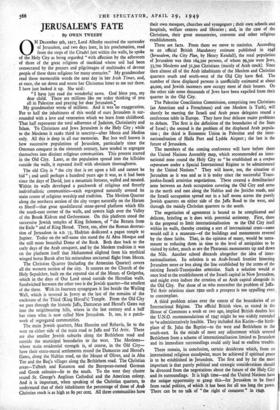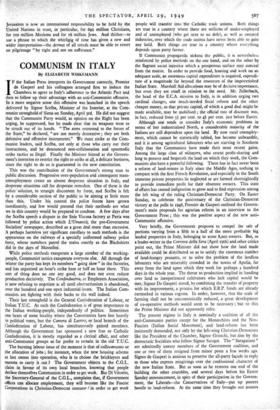JERUSALEM'S FATE
By OWEN TWEEDY
ON December 9th, 1917, Lord Allenby received the surrender of Jerusalem, and two days later, in his proclamation, read from the steps of the Citadel just within the walls, he spoke of the Holy City as being regarded " with affection by the adherents of three of the great religions of mankind whose soil had been consecrated by the prayers and pilgrimages of multitudes of devout people of these three religions for many centuries." My grandmother read those memorable words the next day in her Irish Times, and, at once, she sat down and wrote her Christmas letter to me out there. I have just looked it up. She said:
" I have just read the wonderful news. God bless you, my dear child. There are millions like me today thinking of you all in Palestine and praying for dear Jerusalem."
My grandmother wrote of millions. And it was no exaggeration.
For to half the inhabitants of this world of ours Jerusalem is sur- rounded with a love and veneration which we learn from childhood. That half represents the total adherents of Judaism, Christianity and Islam. To Christians and Jews Jerusalem is the Holy City ; while to the Moslems it ranks third in sanctity—after Mecca and Medina only. All this is deep in all our memories. But less well known is how successive populations of Jerusalem, particularly since the Ottoman conquest in the sixteenth century, have tended to segregate themselves into distinct religious communities. This process started in the Old City. Later, as the population spread into the hillsides outside the walls, it repeated itself with obstinate thoroughness.
The old City is " the city that is set upon a hill and cannot be
hid " ; and until perhaps a hundred years ago it was, as it had been since the days of David, just a mountain fortress, walled and moated. Within its walls developed a patchwork of religious and fiercely individualistic communities—each segregated naturally around its main centre of religious worship and tradition. The Moslem Quarter along the northern section of the city verges naturally on the Haram es Sherif—that great quadrilateral stone-paved platform which fills the south-east corner of the walls, and towers high over the Valley of the Brook Kidron and Gethsemane. On this platform stood the successive Jewish temples of King Solomon, of " the Return from the Exile " and of King Herod. There, too, after the Roman destruc- tion of Jerusalem in A.D. 75, Hadrian dedicated a pagan temple to Jupiter. Today on the self-same site stand the Al Aksa Mosque and the still more beautiful Dome of the Rock. Both date back to the early days of the Arab conquest, and by the Moslem tradition it was on the platform itself that Mohammed alighted from his mythical winged horse Burak after his miraculous nocturnal flight from Mecca.
The Christian Quarter (including the Armenian Quarter) covers all the western section of the city. It centres on the Church of the Holy Sepulchre, built on the reputed site of the Mount of Golgotha, which in the days of Our Lord stood outside the Herodian walls. Sandwiched between the other two is the Jewish quarter—the smallest of the three. With its fourteen synagogues it lies beside the Wailing Wall, which is 'revered in Jewry as the last of the remains of the enclosure of the Third (King Herod's) Temple. From the Old City we pass through the historic Jaffa, Damascus and Herod's Gates out into the neighbouring hills, where in the last century and a half has risen what is now called New Jerusalem. It, too, is a patch- work of segregated communities.
The main Jewish quarters, Mea Shearim and Rehavia, lie to the
west on either side of the main road to Jaffa and Tel Aviv. There are also smaller Jewish suburbs along the Bethlehem road and outside the municipal boundaries to the west. The Moslems— whose main residential strength is, of course, in the Old City— have their extra-mural settlements round the Damascus and Herod's Gates, along the Nablus road, on the Mount of Olives, and in Abu Tor and the Baq'a villages along the Bethlehem road. The Christian areas—Talbieh and Katamon and the European-named German and Greek colonies—lie to the south. To the west they cluster round •St. George's Anglican Cathedral and the American colony. And it is important, when speaking of the Christian quarters, to understand that of their inhabitants the percentage of those of Arab Christian stock is as high as 8o per cent. All three communities have
their own mosques, churches and synagogues ; their own schools and hospitals, welfare centres and libraries ; and, in the case of the Christians, their great monasteries, convents and other religious establishments.
These are facts. From them we move to statistics. According to an official British Mandatory estimate published in 1948 (Jerusalem, the City Plan, by Henry Kendall), the total population of Jerusalem was then 164,30o persons, of whom 99,300 were Jews, 33,700 Moslems and 31,300 Christians (mainly of Arab stock). Since then almost all of the Arab inhabitants of the Moslem and Christian quarters south and south-west of the Old City have fled. The number of these displaced persons is unofficially estimated at about 40,000, and Jewish incomers now occupy most of their houses. On the other side some thousands of Jews have been expelled from their quarter in the Old City.
The Palestine Conciliation Commission, comprising two Christians (an American and a Frenchman) and one Moslem (a Turk), will shortly be meeting the Israeli and Arab peace delegates round a conference table in Europe. They have four delicate major problems to debate. The first is the definition of the boundaries of the State of Israel ; the second is the problem of the displaced Arab popula- tion ; the third is Economic Union in Palestine and the inter- nationalisation of Haifa Port and Lydda Airport ; the last is the future of Jerusalem.
The members of the coming conference will have before them the United Nations Assembly map, which recommended an inter- national zone round the Holy City to " be established as a corpus separatum under a Special International Regime to be administered by the United Nations." They will know, too, the situation of Jerusalem as it was and as it is today since the successful Trans- jordan-Israeli armistice negotiations. These created a demilitarised zone between an Arab occupation covering the Old City and areas to the north and east along the Nablus and the Jericho roads, and the Israeli occupation spread out in a half moon across the purely Jewish quarters on either side of the Jaffa Road to the west, and through the mainly Christian quarters to the south.
The negotiation of agreement is bound to be complicated and delicate, bristling as it does with potential acrimony. First, there is the proposal to limit internationalisation to the Old City itself within its walls, thereby creating a sort of international trust—some would call it a museum—of the buildings and monuments revered by the three faiths. That, in the opinion of many, would be tanta- mount to reducing them in time to the level of antiquities to be visited by ticket, much as are the Pharaonic monuments up and down the Nile. Another school discards altogether the idea of inter- nationalisation. Its solution is an Arab-Israeli frontier bisecting Jerusalem more or less along the line established by the terms of the existing Israeli-Transjordan armistice. Such a solution would at once lead to the establishment of the Israeli capital in New Jerusalem, and might even induce the creation of an Arab capital alongside in the Old City. For those of us who remember the problem of Jaffa- Tel Aviv relations since 1920 such a prospect is too appalling even to contemplate.
A third problem arises over the extent of the boundaries of an International Regime. The official British view, as stated in the House of Commons a week or two ago, implied British doubts lest the U.N.O. recommendations of 1947 might be too widely extended to be administratively feasible. They included Ain Karim—the birth- place of St. John the Baptist—to the west and Bethlehem to the south-east. In the minds of most any adjustment which severed Bethlehem from a scheme of internationalisation limited to Jerusalem and its immediate surroundings could only lead to endless trouble.
There remain, in conclusion, certain desiderata which, from an international religious standpoint, must be achieved if spiritual peace is to be established in Jerusalem. The first and by far the most important is that purely political and strategic considerations should be divorced from the negotiations about the future of the Holy City and its surroundings. It is high time—and the United Nations have the unique opportunity to grasp this—for Jerusalem to be freed from racial politics, of which it has been for all too long the pawn. There can be no talk of " the right of conquest " in 1949. Jerusalem is now an international responsibility to be held by the United Nations in trust, in particular, for 692 million Christians, for 210 million Moslems and for 16 million Jews. And thither—to use a phrase to which the whirligig of time has given a new and wider interpretation—the devout of all creeds must be able to resort on pilgrimage " by right and not on sufferance."



































 Previous page
Previous page